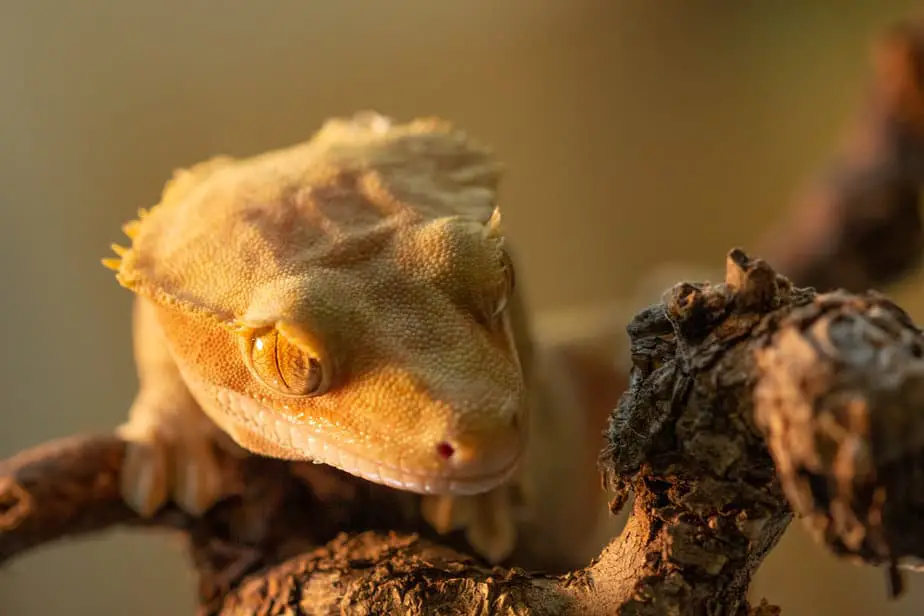Crested geckos, like all reptiles, shed their skin to accommodate growth. This natural process occurs at different stages in their life, with younger geckos shedding more frequently than their adult counterparts.
In the following paragraphs, you’ll learn about the signs of shedding, how often it occurs, and the factors that influence this process.

Signs Your Crested Gecko is Shedding
- Change in skin color: Crested geckos typically turn a different color when they’re about to shed. Their skin may appear grey, paler, or ashy, and sometimes it may darken.
- Patches: The gray areas in their skin may be in patches or cover entire body parts, such as the head or legs.
Frequency:
- Young geckos: Crested geckos will shed more frequently, as they grow faster during the first 6 to 12 months of their lives.
- Adult geckos: As they mature, crested geckos will shed about every 4 to 8 weeks.
Factors Influencing Shedding:
Crested geckos’ shedding rate is influenced by several factors:
- Age: Younger geckos shed more frequently than adults.
- Growth rate: Rapidly growing geckos will shed more often.
- Environmental conditions: Humidity and temperature can directly affect the shedding process.
To help your crested gecko through the shedding process, ensure their environment has a sufficient level of humidity (between 80 to 90 percent).
Be attentive to any shedding problems that may arise and assist your gecko when needed by providing additional support, such as a moist hide. This way, you can keep your crested gecko healthy throughout their shedding cycle.
Recognizing Signs of Shedding
When your crested gecko is about to shed, there are specific signs you should look out for. In this section, we will discuss two main indicators: color changes and behavioral changes.
Color Changes
Before shedding, your crested gecko’s scales may exhibit the following transformations:
- Dull Scales: Scales lose pigmentation and take on a grayish coloration.
- New Growth: The new skin underneath appears vibrant and fresh.
Behavioural Changes
In addition to color alterations, your crested gecko may display certain behaviors indicating the shedding process:
- Hiding: Your gecko might prefer staying hidden and be less active during shedding.
- Rubbing or Scratching: To help remove the old skin, your gecko may rub or scratch against surfaces in its enclosure.
To ensure a healthy and smooth shedding process for your crestie, monitor for these signs and provide a proper environment, such as adequate humidity and hiding spots.
Health and Shedding
Impacted Shedding
Crested gecko shedding is an essential process that signifies growth and good health. However, sometimes the shed may become impacted or stuck, which can lead to problems:
- Humidity: Maintain 60-80% humidity in the enclosure to aid in shedding.
- Hydration: Provide clean water to keep your gecko hydrated.
- Proper Substrate: Use an appropriate substrate to aid in skin shedding.
Keeping your gecko’s environment ideal will reduce the risk of impacted shedding.
Incomplete Shedding
Incomplete shedding occurs when the old skin does not fully come off. Here are some causes and solutions:
Cause: Low Humidity: Ensure adequate humidity levels in the habitat.
Solution: If you notice an incomplete shed, raise the humidity to 80-90% temporarily.
Cause: Stress: A stressed crested gecko may have difficulty shedding.
Solution: Provide a stress-free environment by offering hiding spaces and minimizing disturbance.Cause: Health Issues: Health problems can affect a crested gecko’s shedding process.
Solution: Inspect your gecko regularly and consult a veterinarian if you suspect any health issues.
By keeping a close eye on your crested gecko’s shedding process, you can ensure that they remain healthy and happy.
Care During Shedding
Humidity Requirements
- Increase humidity: During shedding, increase the humidity in your crested gecko’s enclosure to 80-90% as it helps ease the shedding process.
- Misting: Mist your gecko’s enclosure with water twice daily, once in the morning and then once more in the evening.
- Shedding hide: Provide a moist hideout, such as a container filled with damp sphagnum moss, as an additional area for your gecko to retreat and aid in shedding.
Handling Advice
- Avoid handling: Refrain from handling your crested gecko during the shedding process, as it may cause stress and difficulties.
- Monitor progress: Observe your gecko from a distance to ensure the shedding process is progressing smoothly.
- Intervene only if necessary: If you notice any stuck shed on your gecko after the shedding is complete, consult an experienced reptile keeper or a veterinarian for the safest removal methods.
Diet Influence on Shedding
A balanced diet is essential for the overall health of your crested gecko, and it plays a significant role in the shedding process as well. Providing the right nutrients will ensure that the gecko’s skin remains healthy, allowing it to shed properly. In this section, we will discuss how diet can influence shedding in crested geckos.
Your crested gecko’s diet should consist of:
- Crested Gecko Diet: This is a commercially available, specially formulated food that contains essential nutrients for your gecko. It’s available in a powdered form, which can be prepared by mixing with water. Offer this to your gecko every other day.
- Insects: Feeding your crested gecko with insects is essential in providing necessary proteins and fats. Choices include crickets, dubia roaches, and mealworms. Be sure to dust insects with calcium powder to ensure proper calcium intake. Feed insects to your gecko twice a week.
The following dietary considerations can help ensure healthy shedding:
- Hydration: Dehydration can cause incomplete or difficult shedding. Make sure to provide a source of clean water for your gecko. Additionally, mist your gecko’s enclosure daily to maintain proper humidity levels.
- Calcium: Calcium is essential for healthy skin. Use calcium supplements to avoid any issues related to shedding or skin health.
- Variety: Providing a diverse diet can improve overall health and encourage proper shedding. Consider rotating different types of insects and crested gecko diet formulations.
